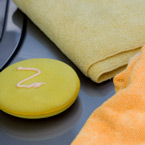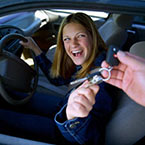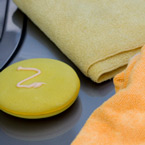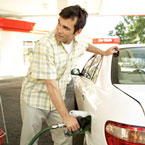 Critical thinking, decision making and problem solving are all skills vital to your role as a car owner. Ironically, similar qualities are also required for more leisurely tasks, such as brain teasers. So in the spirit of sharpening our cognitive abilities, here’s a round of our favorite exercises at DCH Kay Honda, courtesy of Daily Brain Teaser, to test your wits. Critical thinking, decision making and problem solving are all skills vital to your role as a car owner. Ironically, similar qualities are also required for more leisurely tasks, such as brain teasers. So in the spirit of sharpening our cognitive abilities, here’s a round of our favorite exercises at DCH Kay Honda, courtesy of Daily Brain Teaser, to test your wits.
1. Which city is three fifth chick two third cat and 50 percent goat?
2. What has one letter and starts with an ‘E’?
3. Find the unique characteristic of the following words: coughing, thirsty, defiant
4. What is a 10-letter word in the English language that can be typed using only the top rows of the computer keyboard?
5. Which word reads the same when written forward, backward or upside down?
Answers are below.
- Chicago
- A single Envelope
- Each word has three consecutive letters of the alphabet: coughing, thirsty, defiant
- Typewriter
- Noon
 At first glance, the warmth of summer may not seem to pose much of a threat to your car, but the hot sun and dry conditions can pose a problem to the well-being of your car’s exterior. As much as you need to protect your car from the rigors of winter, the summer brings with it some new challenges. Learn more from DCH Kay Honda with these summer maintenance tips for your car’s exterior. At first glance, the warmth of summer may not seem to pose much of a threat to your car, but the hot sun and dry conditions can pose a problem to the well-being of your car’s exterior. As much as you need to protect your car from the rigors of winter, the summer brings with it some new challenges. Learn more from DCH Kay Honda with these summer maintenance tips for your car’s exterior.
If you live in a climate where you contend with snow and ice during the winter months, one of the first things to do this summer is ‘un-winterize’ your vehicle. For starters, clean the undercarriage of the car with a hose to thoroughly to remove any deposits of salt and grit that may have built up through the winter. Not only will these deposits potentially cause corrosion, they will also cause the engine and transmission to run hotter, thus making it more difficult for your car to run efficiently in hot weather.
It is also important to wash your car regularly during summer months. A weekly wash will ensure dirt is quickly removed from your car, as to not cause damage to the paint work. Sap from trees and bird droppings, for example, can build up on your car and quickly damage the exterior. When washing your car, consider using an auto-detailing clay bar to easily remove bugs, sap and other deposits, which cause scratches and or other marks.
Location is another consideration in maintaining your car’s exterior this summer. For instance, you want to make sure that you are in a shaded location while washing your car. Afterward, spray your car with a hose and use a paint-safe microfiber cloth to rub the paint work. Following a thorough washing and rinse, it is advisable to use a cotton detailing cloth to dry off the whole surface of the car, as opposed to leaving your car to dry in the sunlight where it is vulnerable to water spots and mineral deposit formation.
Sealing paint work is another important step in protecting the exterior of your car from direct sunlight and preserving its vibrant color. Luckily, paint sealant lasts for several months after application. A quality wax job, following sealant application, will finish the look off. As mentioned, it is important to avoid adding the finishing touches to your car in a sun-drenched area, or else the wax may not properly adhere to the vehicle’s exterior.
While some may enjoy maintaining the exterior of their vehicle, it may be a cumbersome task for others. We recommend that you leave the hard work to us this summer and schedule a full detail at our dealership.
Posted in Car Care
|
Tagged Summer
|
 When it comes to planning family day-trips, unlimited funds would be ideal. But realistically, our budgets often prevent us from enjoying all of the pricey summer activities that we wish to experience. However there’s no reason you cannot still enjoy a great vacation. Here are some ideas from DCH Kay Honda that will help keep the kids entertained for less this summer. When it comes to planning family day-trips, unlimited funds would be ideal. But realistically, our budgets often prevent us from enjoying all of the pricey summer activities that we wish to experience. However there’s no reason you cannot still enjoy a great vacation. Here are some ideas from DCH Kay Honda that will help keep the kids entertained for less this summer.
Nature
Log on to the Internet and do a Google search for national parks and other areas of natural beauty near where you live. Many local parks and scenic places are completely free to visit. You can even enhance your experience with a family bike ride on park trails or by packing food for a picnic.
Museums
Though adults may need to pay an entry fee to museums or art galleries, kids can enjoy the surroundings without charge. Many venues even offer free tours and activities for children. You can also choose museums or galleries that feature exhibits of interest to your children.
Guided Tours
Many towns and cities have guided tours, which you can download online or pick up at certain local venues. These tours enable you to spend the day exploring on foot, keeping car use to a minimum, as to preserve fuel. Kids will also love learning more about their hometown. Search online for details of attractions in your area.
The Beach
Of course, the beach is always a hit with the kids. So if you live relatively close to the sea, then you will never be short of cheap day trips. Load the car up with towels, toys, food and drinks and head to the beach for some sun and surf. Beach boardwalks often provide economical entertainment, too.
Posted in Travel
|
Tagged family, Summer
|
 As a DCH Auto Group dealer, DCH Kay Honda is a proud supporter of Students Against Destructive Decisions (SADD). Therefore, we couldn’t be more excited to share news of the recent SADD National Conference! As a DCH Auto Group dealer, DCH Kay Honda is a proud supporter of Students Against Destructive Decisions (SADD). Therefore, we couldn’t be more excited to share news of the recent SADD National Conference!
Each year, the Student Leadership Council (SLC) successfully curates the SADD National Conference for fellow student leaders — and this year was no exception. After kicking off on June 22 in Orlando, Florida, the annual DCH-sponsored event went off without a hitch for the near 600 students and adults in attendance.
Over the course of four days, participants were treated to fun-filled, albeit enlightening, activities such as youth health-related workshops and exhibitions. Additionally, young adults enjoyed interactive presentations on leadership, advocacy and prevention education from renowned speakers. Students were also able to take advantage of unique networking opportunities with members of other SADD chapters from across the country.
Young adults at the conference were ultimately equipped with profound insight to bring back to their respective chapters, schools and communities. Needless to say, our dealership could not be happier to have played a role in such a dynamic event!
We invite you to learn more about SADD and the 2013 SADD National Conference by visiting SADD’s website at http://sadd.org.
 Critical thinking, decision making and problem solving are all skills vital to your role as a car owner. Ironically, similar qualities are also required for more leisurely tasks, such as brain teasers. So in the spirit of sharpening our cognitive abilities, here’s a round of exercises from Daily Brain Teaser to test your wits, on behalf of our team at DCH Kay Honda. Critical thinking, decision making and problem solving are all skills vital to your role as a car owner. Ironically, similar qualities are also required for more leisurely tasks, such as brain teasers. So in the spirit of sharpening our cognitive abilities, here’s a round of exercises from Daily Brain Teaser to test your wits, on behalf of our team at DCH Kay Honda.
1. What occurs twice in a week, once in a year, but never in a day?
2. Can you decipher the following common phrase?
T M C
A U O
H S M
W T E
3. Find the next number in the sequence:
5 12 24 36, __
4. The first two letters of this word refer to a man, the first three letters refer to a woman, the first four letters refer to a great man and the whole word refers to a great woman. What is the word?
5. What is something that is always coming but never arrives?
Answers are below.
- The letter “E”
- What goes up must come down.
- 52, solution = sum of consecutive prime numbers
(2+3 , 5+7 , 11+13 , 17+19 , 23+29)
- Heroine.
- Tomorrow / The future
What are some of your favorite brain-training riddles?
Posted in Brain Teasers
|
Tagged fun, riddles
|
 Q: How often should I wash my car? Q: How often should I wash my car?
A: Based on your preference, cleaning the car is either a chore or a pleasure, but most people agree that they love to see their vehicle shiny and clean.
Car detailing experts would recommend that your car is cleaned weekly, but your busy schedule is unlikely to be able to cope with that. Car owners clean their cars at very different intervals. Some will clean the car at regular intervals, whereas others will simply do the job when the car is so dirty they can no longer see the paint work. So, what is the ideal frequency for cleaning the family car? Our team at DCH Kay Honda believes the answer to that question will vary according to a variety of different factors, such as location, mileage, climate and your purpose for driving.
Location
Where you live has a big impact how often you should wash your car. If it is parked on a busy road, with lots of traffic, then it may pick up a load of dirt from the road. Likewise, if you live in a coastal region, then your car may well regularly be covered in salt spray and debris. If your car is parked under trees then it may become very dirty, very quickly with sap from the trees or bird droppings. If this is the case, then try to wash your car weekly. If you live in a very clean, quiet location, then a monthly clean is probably sufficient.
Mileage
How frequently you drive your car also has affects your car’s spotlessness. As a general principle, the more miles that you drive, the more frequently you will need to clean the car. More highway miles mean more dirt and debris on the paint work. Where you drive your car also has an impact on its otherwise pristine exterior. If you drive through a rural area then you are far more likely to get bugs on the windshield and front grille. In these conditions, you may want to wash your car every other week.
Climate
The climate and air temperature are also important considerations. In very cold climates, snow and grit from the roads can quickly erode and damage your paint work. Conversely, in very hot climates, the problem of erosion can be accelerated, as chemicals in contaminants become more active in hot temperatures. Tree sap, dead bugs and bird droppings can all very quickly cause permanent damage if left on a hot car for an extended period of time. During hot or very cold weather, washing the car weekly is highly recommended.
Purpose
The reason(s) for using your car will also have an effect on the frequency with which you wash it. If your car is used to visit clients or even to drive them around, then it needs to be kept spotlessly clean. If your car is a company vehicle and displays graphics advertising the business, then it too needs to be cleaned almost daily to ensure a professional image. If, perhaps, you use your car for off-road driving in your own time, then you may not be as inclined to clean it so frequently.
 With the cost of fuel generally on the rise, savvy car drivers are always on the lookout for ways to improve gas mileage. There are many different factors that can influence your fuel efficiency. The car you drive certainly makes a big difference, but so does the way you drive, the road you drive on and even the weather conditions. With the cost of fuel generally on the rise, savvy car drivers are always on the lookout for ways to improve gas mileage. There are many different factors that can influence your fuel efficiency. The car you drive certainly makes a big difference, but so does the way you drive, the road you drive on and even the weather conditions.
During the summer months, your car is likely to endure high temperatures and a lot of sunshine. So what impact will this type of weather have on your fuel efficiency?
As soon as the weather gets hot, most drivers are likely to reach for the air conditioning to cool them down. Many drivers believe that air conditioning may increase the fuel consumption, preferring instead to roll the windows down. By allowing fresh air to keep the car cool, you may believe that you are conserving energy. However, this idea may be untrue.
The Society of Automotive Engineers (SAE) conducted a study to see whether it was more fuel efficient to drive with the window down or to have the air conditioning on. What the study found was that when you drive at speeds of more than 55 miles per hour with the windows down, the fuel efficiency can decrease by more than 20 percent. Conversely, by having the air conditioner on and the windows closed, the fuel efficiency decreased by only 10 percent. By keeping the window or windows open, you will interfere with the car’s aerodynamics, causing more drag. This means that the engine has to work harder and consume more fuel to maintain the speed you want.
Therefore, when driving in summer at speeds above 55 miles per hour, it is better to have the windows closed and the air conditioner on. However, this may not be the case if you are simply cruising around town. At lower speeds, the study recommends that you switch the air conditioner off and open the windows. At these speeds, the engine is not producing enough energy to make the air conditioning efficient, so you will actually see better gas mileage if you roll the windows down. This may not be desirable in stationary traffic, but it is important to be aware that if the car is stationary, then fuel efficiency will suffer if you have the air conditioner on.
It is also worth remembering that driving a long distance in a convertible with the top down will drain the fuel faster than with the top up. The sunny weather and blue skies may make the convertible seem like a romantic option, but consider the significant increase that this will create in fuel consumption before you get too carried away.
If you have any questions regarding your fuel efficiency, or if you are in need of a service appointment before hitting the road for your summer vacation, do not hesitate to contact our team at DCH Kay Honda today!
American drivers love their automatic transmissions. Driving an automatic transmission is generally much more convenient than a manual version, but drivers are often warned of some of the downsides of this choice. Automatic transmissions may be easier in use, but they can also be more expensive to maintain. Drivers may also fear that fuel consumption in an automatic transmission is always poorer than that of a manual transmission.
This was certainly once true. Manual transmissions have traditionally offered better gas mileage than automatics. There are two reasons for this. With an automatic transmission, drivers are more likely to down shift more quickly than in a manual version. Down shifting to a lower gear means that engine runs at a higher number of revolutions per minute. This means that it is using fuel less efficiently. With a manual transmission, you can simply press the gas pedal harder to maintain your speed without down shifting.
The second reason is that manual transmissions did not once consume as much power as an automatic transmission. The nature of an automatic transmission means that more power is used to operate the different parts. Manual transmissions can be more efficient, because the driver does more of the work.
However, car manufacturers know that buyers often prefer to drive automatic transmissions, and do not want to be deterred by issues over fuel efficiency. Technology developments now mean that automatic transmissions can offer equal or even better fuel efficiency than their manual counterparts. Advances in automatic transmissions mean that shift changes are now often much quicker and efficient than they once were, and that the parts use less energy overall. Some manufacturers offer economy (or ECO) options to ensure that the car uses as little fuel as possible. These developments ensure that the automatic transmission able to offer more miles per gallon.
It is also true to say that the transmission is only one part of the picture. All the other parts of the car also play an important part in fuel efficiency, and manufacturers and designers are able to engineer automatic cars to ensure that they are more fuel-efficient. Driver behavior plays an important role too. Driving a manual car takes practice and skill, and certainly isn’t easy. To get the most from the car, a manual transmission needs to be used in a certain way, and many drivers are not up to the task. That means that any potential gains in efficiency from the use of the technology are quickly wiped out by losses from driver error.
If you want to understand more about the differences between manual and automatic transmissions, visit DCH Kay Honda for more information.
We all know how risky texting while driving can be, but it’s not the only kind of distracted driving that can have dangerous consequences.
In response to concerns over the swarm of new technology in today’s cars, the Department of Transportation’s National Highway Traffic Safety Administration (NHTSA) have released a set of voluntary guidelines for automobile manufacturers to help limit dangerous distracted driving practices.
While these guidelines are directed towards auto manufacturers, we at DCH Kay Honda think that these recommendations can be useful for drivers, too.
Keep your eyes on the road
The NHTSA suggests that vehicle makers limit the amount of time that drivers have to take their eyes off the road to use certain functions on electronic features. The recommended time limit is two seconds at a time for a total of 12 seconds. To stay safe while driving, try to limit the amount of time you spend fiddling with your car’s gadgets so you can keep your eyes on the road.
Don’t use certain features while your vehicle is in motion
The NHTSA also recommends that automobile makers program certain features to automatically disable when the car is in motion, such as internet browsing functions, video content, and social media. If your current vehicle has these types of features or others that might be too complicated to use while driving, consider pulling over and stopping in a safe place before using them.
The take away for drivers is that while in-vehicle technology can be convenient, it can also pose risks if not used safely. Help decrease your chances of getting in an accident and avoid being a distracted driver by exercising caution when using these features.
If you’d like to learn more about the dangers of distracted driving, the NHTSA has several resources available on their website. And be sure to check out the DCH Kay Honda Facebook page and let us know how you stay safe on the road.
After 37 years of production, nobody will deny that the Accord is anything less than legendary, so Honda is quick to note its importance. With new competition from rival brands, Honda took it upon itself to redesign its icon in the midsize sedan segment, but has the Accord kept its focus in this all-new model?
One thing that hasn’t changed in the Accord is that it’s still built right here in the United States. After 30 years of continuous Accord production in America, both the Accord coupe and sedan models will be built in two locations in Ohio. The Accord’s place of production might have stayed the same, but that’s just about the only thing that has.
With fuel prices climbing higher and higher, and the pressure to reduce oil dependency on the rise, Honda took it upon itself to look at how to make the all-new 2013 Accord even more efficient. Being a brand that prides itself on engineering new technologies, Honda completely overhauled the 2013 Accord’s powertrain options.
While a plug-in hybrid Accord is expected for the 2014 model year, the 2013 Accord sedan and coupe will feature two Earth Dreams™ engines, each featuring improved fuel economy while offering even more performance. Buyers have choice of either an all-new direct-injected 2.4-liter four-cylinder, or a highly revised 3.5-liter V6, which just so happens to be Honda’s most powerful V6 to date.
Buyers favoring highly impressive fuel economy for a non-hybrid model will undoubtedly find solace in the standard i-VTEC 2.4-liter four-cylinder. With 185 horsepower and 181 pound-feet of torque on tap, performance is never lacking, yet EPA fuel economy ratings of 27 miles per gallon city and 36 miles per gallon highway will surely impress*. Those high numbers are increases of 4 and 2 mpg, respectively, and come courtesy of all-new continuously variable transmission (CVT), while buyers will have the option of a 6-speed manual for sportier driving.
The Earth Dreams™ four-cylinder may be both more powerful and more efficient, but the revised Earth Dreams™ 3.5-liter V6 also features those traits. Now delivering 278 horsepower and 252 pound-feet of torque, the V6 can shut down three cylinders for increased fuel efficiency, although this engine can either be mated to a 6-speed manual or all-new 6-speed automatic transmission. Compared to last year, drivers can expect 2-3 more miles per gallon depending on driving, with official numbers coming in at 21 city/32 highway with the 6-speed automatic*.
Sure, the powertrains might be a huge step forward for the Accord sedan and coupe siblings, but there’s much more to be impressed by. The exterior may be stylish, but it’s more of a case of form meets function. Despite being slightly shorter in overall length, interior capacity remains largely the same as last year, with dimensions actually improving in some regards. This means you get the same roomy feeling inside, while having a smaller package on the outside, leaving you with a more maneuverable vehicle in those tight spots.
The new, aerodynamic shape of both the Accord sedan and coupe improve fuel efficiency while creating a quieter interior for increased comfort. That stylish and efficient body shape lends itself well to the nine available paint colors on sedan variants, and seven on coupes. Other exterior features, some of which are optional, include LED brake lights, a rearview camera, automatic headlamps, power moonroof, and extensive use of high-tensile steel for improved safety and structural rigidity.
A completely new interior was also designed to further complement the improved exterior trimmings. Let us just say that the design of both exterior and interior is impressive, finding that sweet spot between highly functional and strikingly stylish. As stated earlier, interior dimensions were improved despite the smaller exterior dimensions, featuring increased rear legroom and trunk capacity, among other dimensions. Interior trimmings are available in black, gray, or ivory colors, in either cloth or leather form.
2013 is a big year for technology in the Accord, with features added inside and out. The Accord doesn’t leave drivers wanting in any technological area, instead leaving no doubt that they have every possible tool at their disposal. An 8-inch color display, known as “intelligent” Multi-Information Display (i-MID) finds itself front and center in the dash, controlling many of the Accord’s newfound tech toys.
Bluetooth HandsFreeLink comes as standard, while Eco Assist™ helps drivers maximize fuel economy. Pandora internet radio is also on hand, and there’s even a SMS text messaging function for increased safety. Dual-zone automatic climate control is standard equipment, while such safety features as Honda LaneWatch™, which displays a wide-angle view of the passenger side roadway on the i-MID screen, and Lane Departure Warning (LDW) are available for the first time. Adaptive Cruise Control (ACC) is also an available safety feature finding its home in the Accord for the first time, and LED daytime running lights are standard on higher trim levels.
Even more exciting is that LED headlamps are available on the 2013 Accord Touring sedan, a first for the Honda brand. Often found on only the most expensive luxury vehicles available, the LED projector array means increased visibility and safety with decreased power usage.
Deciding on what Accord you want most might be the most difficult decision you’ll face, with LX, Sport, EX, EX-L, EX-L V6, and Touring trims available for sedan models, and LX-S, EX, EX-L, and EX-L V6 trims found on coupes. No matter which bodystyle, trim level, or options you choose, there’s no doubt you’ve made the right decision with the 2013 Honda Accord. It may be redesigned for a new generation, but its excitement is matched by the quality product associated with the nearly-40-year old Accord nameplate.
To find your new 2013 Honda Accord, visit us at DCH Kay Honda today.
* 24 city/34 highway/28 combined mpg rating for 4-cylinder Sedan 6MT models. 27 city/36 highway/30 combined mpg rating for Sedan CVT models. 26 city/35 highway/29 combined mpg rating for Sport Sedan CVT models. 21 city/34 highway/25 combined mpg rating for V-6 Sedan models. Based on 2013 EPA mileage ratings. Use for comparison purposes only. Your actual mileage will vary depending on how you drive and maintain your vehicle.
|
 Critical thinking, decision making and problem solving are all skills vital to your role as a car owner. Ironically, similar qualities are also required for more leisurely tasks, such as brain teasers. So in the spirit of sharpening our cognitive abilities, here’s a round of our favorite exercises at DCH Kay Honda, courtesy of Daily Brain Teaser, to test your wits.
Critical thinking, decision making and problem solving are all skills vital to your role as a car owner. Ironically, similar qualities are also required for more leisurely tasks, such as brain teasers. So in the spirit of sharpening our cognitive abilities, here’s a round of our favorite exercises at DCH Kay Honda, courtesy of Daily Brain Teaser, to test your wits.










